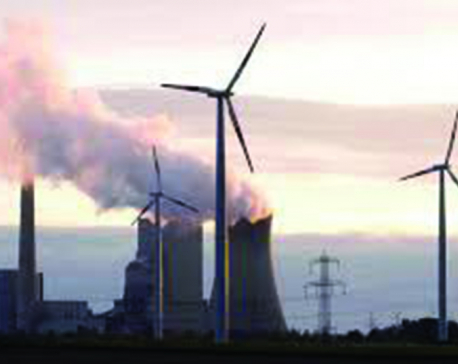
OR

Right to clean environment is the fundamental right granted by the constitution. Health of general public should not be compromised in the name of development
The real-time Air Quality Index (AQI) of Kathmandu was as high as 117, which is considered to be ‘unhealthy’ for sensitive groups, according to the Air Quality Monitor (AQM) installed at Phora Durbar Recreation Center in Thamel area, even after the rain as I sat down to write this piece. Thanks to the April rain that has given some relief from Kathmandu’s pollution. Kathmandu is notoriously known as ‘maskmandu’, ‘dustmandu’ etc for its dusty and smoky state. The quality of air in this bowl-shaped valley is degrading every day. In recent times, Nepal’s air quality, especially of Kathmandu, the capital, has been reported as one of the worst in South Asia.
Nepal is not performing well when it comes to combating air pollution. According to Environmental Performance Index 2018, Nepal ranked 176th slipping 27 points from 149th in 2016 and was on the bottom five. Three of the bottom five countries were from South Asia, the region that has been known for its severe air pollution for years. Air pollution causes more than four million deaths each year globally. And 37 percent of these deaths are from South and South-East Asia alone.
I could only imagine the situation of Delhi when my father often postponed his return ticket to Indian capital after celebrating Dashain and Tihar in October. The nasty news about New Delhi’s pollution would usually come in the first week of November, weeks after Deepawali. “It gets terrible for couple of weeks as toxic haze blankets Delhi forcing people to stay indoors”, he would say. Vehicular emissions and smoke from burning crops in neighboring states and fireworks from Deepawali are regarded as the major causes of air pollution in Delhi.
Although Kathmandu is not as bad as Delhi in terms of air pollution yet, the situation will worsen unless the government takes concrete measures to control it. Rapid urbanization, derailment of road widening project and underground installation of drinking water pipes have contributed Kathmandu’s dust pollution. Furthermore, increasing motorization, smoke from brick kilns and vehicular emissions especially from the old and outdated motors plying in the city roads have made Kathmandu almost like a toxic gas chamber.
Killer air
Owing to population growth and industrial activities, the quality of air is degrading all around the globe. According to World Health Organization (WHO), 91 percent of world’s population lives in places where quality of air is at hazardous levels and exceeds WHO guidelines on healthy air. Every day, thousands of tons of smokes, dust particles and toxic gases are produced from industries, mines, cities and households around the world. This pollutes the air around us making breathing difficult. Since breathing cannot be skipped or avoided just like avoiding contaminated water or food, we are forced to inhale the air as it comes regardless of its quality.
Today, we seem to be paying heavy price for breathing the air that should have come for free. We are even making innocent animals suffer from the pollution. Air pollution causes various environmental problems including acid rain and global warming and damages people’s health. Air pollution, regardless of class and age, affects all around the globe.
City of dust
The concentration of Particulate Matter (PM) is often higher in Kathmandu during the peak traffic hours. The inversion layer formed in the valley’s atmosphere often acts as the blanket to trap the pollutants thus keeping the place polluted for hours. The concentration of PM exceeds the WHO guidelines.
According to 2010 State of Global Air report, Nepal’s pollution level is soaring. Nepali children born today will die 30 months sooner on average, said the report. Worsening air quality will have severe health impacts on our population especially on infants as it negatively influences children’s physical and cognitive development. A study suggests that Nepal’s average life expectancy would increase by 4.4 years, if air pollution level were brought within WHO guidelines. This clearly indicates that the impact of air pollution is not limited to respiratory infections, coughing and itching but is a leading cause of chronic cardiovascular and lung diseases.
Experts say that a third of the Valley’s pollution is caused by vehicular emissions that come from hundreds of thousands of vehicles, including the outdated and poorly maintained ones. Quality of air deteriorates during the peak traffic hours due to vehicular exhausts. Environmental and public health experts opine that wide roads will only encourage more people to have cars and motorbikes resulting in more traffic and more pollution.
Despite being a walkable city, Kathmandu, as the studies have revealed, is not pedestrian-friendly. According to traffic police record, 226 pedestrians were killed in 27,650 accidents in the last five years. Lack of minimal walking facilities such as sidewalks, crosswalks and traffic lights have turned the city into a death zone for pedestrians. In order to combat Kathmandu’s air pollution, more efforts and investments are required in building pedestrian-friendly infrastructures. Similarly, convenient public transport should be in place and diesel and petrol motors should be replaced by electric vehicles. Government should focus on people-centric development.
In addition to vehicular emissions, brick kilns around the valley as well as waste burning pose great threat to valley’s air quality. A study conducted by the Department of Environment shows the burning of waste contributes 19 percent to the air pollution. And there are behavioral issues and lack of awareness among the general public regarding open burning of waste. Despite the ban on the open burning as envisioned in Solid Waste Management Act, people are often seen recklessly burning the garbage, especially papers and plastics, in the streets in front of their homes and shops and such incidents go unchecked.
Measures to take
We have laws and regulations in place but when it comes to implementing them, concerned authorities and government always let us down. Stringent rules and regulations should be in place to punish polluters and effective monitoring should be done to ensure laws are not violated. Government should also introduce advanced technologies and instruments to record, study and analyze the air quality data so as to develop strategies to deal with the issue.
Right to clean environment is the fundamental right granted by the constitution. Health of general public should not be compromised in the name of development.
sandip.neupane24@gmail.com
You May Like This

Together against climate threat
Climate change and environment preservation are defining issues of our times. We need to take action, individually and collectively ... Read More...

Together against pollution
Air pollution should be controlled immediately. Otherwise, we will witness huge loss in human resources, production and economic growth ... Read More...

African malaria threat
Malaria imported from African continent has been increasing steadily in the last few years, and is posing unnoticed public health... Read More...











Just In
- Japanese envoy calls on Minister Bhattarai, discusses further enhancing exchange through education between Japan and Nepal
- Heavy rainfall likely in Bagmati and Sudurpaschim provinces
- Bangladesh protest leaders taken from hospital by police
- Challenges Confronting the New Coalition
- NRB introduces cautiously flexible measures to address ongoing slowdown in various economic sectors
- Forced Covid-19 cremations: is it too late for redemption?
- NRB to provide collateral-free loans to foreign employment seekers
- NEB to publish Grade 12 results next week








Leave A Comment